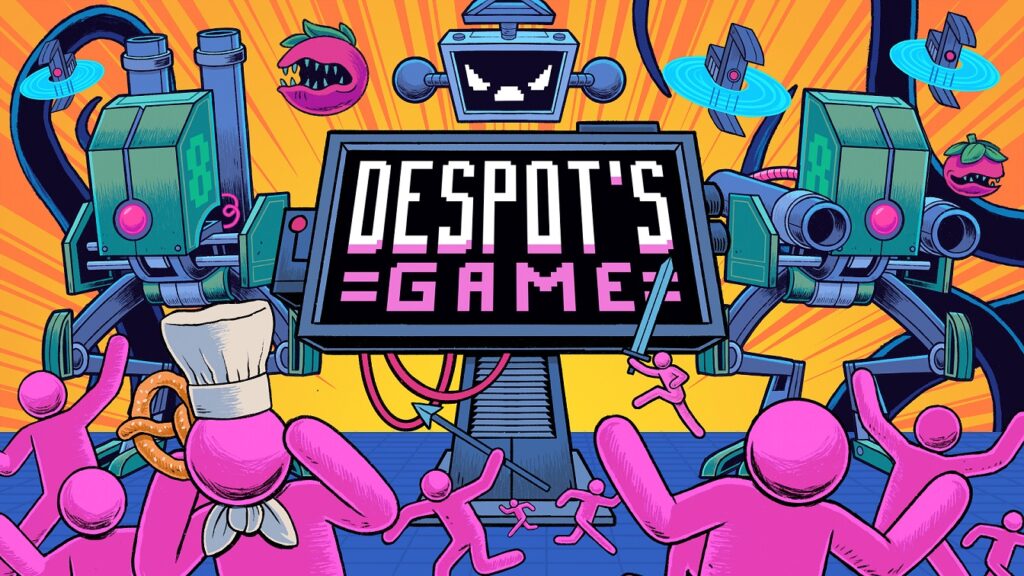Konfa Games’ Despot’s Game opens in a dark world controlled by a sadistic, almost godlike artificial intelligence named “Despot.” It is a world where humanity is seemingly under Despot’s digital thumb and thrust into a dark, infinitely winding dungeon filled with all kinds of horrors and only the fleeting chance of survival. However, the game promises that you, dear player, are the chosen one destined to lead a group of human survivors out of the dungeon and into a better world.
After the game tells you this, it immediately laughs at you, tells you it was messing with you, and promises that you will die in the dungeon’s horrifying deaths many, many times. Though darkly funny, the game is telling you the truth this time. Your treks through the dungeon’s many rooms will end in failure more often than they succeed, but, true to the opening joke, that consistent failure never stops being fun.
Part of this is due to the game’s presentation. Despot’s Game’s pixelated art style is wonderful to look at, with the enemies’ sprite work being distinct and lively. The robots and monsters of Despot’s Game have a lot of personality when ripping apart your army of humans. In contrast, your human units are copy-pasted and only distinguished by the weapons you give them, hammering home their disposable nature within the game’s narrative. In general, the pixelated graphics do well to remind the player that, to the titular Despot, the struggle for survival is nothing more than a game to both him and you. It encourages a disconnect to the human units that helps the nihilistic tone the game strives for and helps the player to not take their losses too seriously. I say this as a good thing, as the game wants you to push yourself to try and delve deeper and deeper into the dungeon’s depths with your human pawns. After all, it’s a game, and a game is meant to be played.

The dungeon is also very fun to explore, as each floor within the dungeon has its own distinct look and enemies. There’s a lab biome with mechanical enemies (the starting floor), and then you can explore a more traditional dungeon biome or a forest biome. The act of exploring the dungeon’s various biomes and floors is also worthwhile. On each floor of the dungeon, the player must traverse rooms filled with enemies and items to replenish your small army’s resources. Moving through each room of a floor costs food, and the cost of food goes up according to the size of your army. This will lead players to try and gain food as well as weapons and upgrades, but food either costs money or the sacrifice of one of your people. This forces the player to constantly make choices between food, money for upgrades or weapons, and soldiers at every turn, which in turn helps to make the player think about resource management on top of strategy and upgrades. The game’s roguelite elements add more variety to this exploration, as the arrangement of each floor is randomized when starting a new run, meaning the distance between the player and the floor’s boss room can vary wildly which, in turn, makes the risk of running out of food, resources, or manpower even more likely.
Of course, you will have to fight your way to that boss room, and the game’s auto-brawler-style combat is also a treat. Though each human unit starts out the same, the player can assign them a different class through the weapons that can be found or bought in the dungeon. Each class can be upgraded through mutations that can be found by exploring the dungeon, having multiple units of a class, or through upgrading a set of blanket attributes with the money earned through fights. The resource-management aspect of the game comes back through this upgrade system as the game’s economy once again forces the player to think about what is more important when exploring: units and weapons, upgrades for your units, or food. You need weapons to fight, upgrades for your army, or food to continue exploring. What do you spend your money on after a particularly bad fight? How would you maximize your forces to avoid that scenario in the first place? What class should make up the bulk of your forces? Should you focus on building up a large army in the early game even though that would take up more food? Should you explore each floor thoroughly for the slight possibility of finding good weapons? More than the enemies it throws at you, questions and choices like these are what make Despot’s Game difficult.
Despot’s Game is a game about choice. The humans in the dungeon are mere pawns for you to maximize in your game against the Despot, and each death in each failed run is just an opportunity for you to learn how to do better with your next batch of human soldiers. In this way, the game can be somewhat nihilistic in how it views its humans, treating them with a kind of humorous contempt as it delights in telling you how often they will die. Of course, that’s part of Despot’s Game’s charm. It invites you to take on the role of a detached god who uses mankind as a plaything, and that’s a kind of power fantasy that’s just too good to pass up.
I give Despot’s Game a 9/10.
For more information, visit https://www.despotsgame.com/
Related: Reviews by Josh Freeman
I love games and love talking about games. Some of my favorites include action games (both 2D and 3D), metroidvanias, roguelikes, shooters, and Indies.





More Stories
I AM FUTURE Review for PlayStation 5
GTA Online: Money Fronts, HSW Race Bonuses, Free Hands-on Car Wash Property, Plus Much More
The Legend of Heroes: Trails beyond the Horizon Unveils Opening Movie Ahead of Jan. 15 Release Date